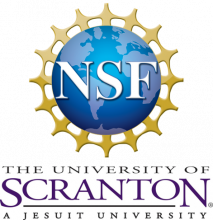NSF Awards Grant for the Development of the HamSCI Personal Space Weather Station
NSF Awards Grant for the Development of the HamSCI Personal Space Weather Station

By Stan Zygmunt, University of Scranton
A $1.3 million National Science Foundation (NSF) grant awarded to University of Scranton physics and electrical engineering professor Nathaniel Frissell, Ph.D., seeks to harness the power of a network of licensed amateur radio operators to better understand and measure the effects of weather in the upper levels of Earth’s atmosphere.
The highly-competitive grant awarded by NSF’s Aeronomy Program for the project titled Distributed Arrays of Small Instruments (DASI) will be implemented over a three-year period. As lead principal investigator, Dr. Frissell, a space physicist, will lead a collaborative team that will develop modular, multi-instrument, ground-based space science observation equipment and data collection and analysis software. He will also recruit multiple universities and ham radio users to operate the network of “Personal Space Weather Stations” developed.
The space weather equipment will be developed at two levels of sophistication: one at a low-cost, easy-to-use level for the ham radio operators; and one that is more complex for university partners that will allow for the collection of additional data.
“The equipment and network allows us to measure and characterize ionospheric and geomagnetic short-term, small scale variability on a large geographic scale in order to understand the response of the ionosphere to sources from above (space weather) and below (atmospheric forcing),” said Dr. Frissell in the grant project proposal. “By designing Personal Space Weather Stations variants at multiple price points, open sourcing the hardware and software, and directly engaging with the ham radio community, this project maximizes the chances of widespread adoption of this system.”
In the U.S., there are more than 730,000 licensed amateur radio operators and nearly 3 million worldwide. For this initiative, Dr. Frissell will target the ham radio community through the Ham Radio Science Citizen Investigation collective, which he leads, and the TAPR (Tucson Amateur Packet Radio) amateur radio engineering organization.
According to Dr. Frissell, measuring and better understanding modulations in the upper atmosphere – specifically the ionosphere – is important because these changes can affect radio transmissions as well as satellites, which then can affect the internet, cellphones, GPS systems and more. He also explained that radio remains a very important communication tool because it is a way of communicating worldwide that doesn’t rely on infrastructure. Radio communications can bounce (refract) off the ionosphere and return to earth. This process can repeat multiple times – for example, allowing people in the U.S. to communication with people in Australia – without the use of expensive satellites.
Already published research by Dr. Frissell using data collected by existing Ham radio users shows the sensitivity of the existing technology and the capacity of network of licensed radio enthusiasts to measure modulations produced in the ionosphere. In the study “Modeling Amateur Radio Soundings of the Ionospheric Response to the 2017 Great American Eclipse,” published in Geophysical Research Letters, Dr. Frissell measured changes in the ionosphere during the solar eclipse. The data he used was collected by hundreds of licensed ham radio operators in the U.S. who participated in a contest he ran that allowed him to collect the data he needed for the analysis. The new initiative expands this model and provides additional equipment to add to the data to be collected and analyzed.
Collaborators in the NSF funded DASI project with Dr. Frissell include: William Engelke and Travis Atkison, Ph.D., of the University of Alabama; David Kazdan, Ph.D., and Soumyajit Mandal, Ph.D., of Case Western University; Hyomin Kim, Ph.D., of the New Jersey Institute of Technology Center for Solar-Terrestrial Research; Phil Erickson, Ph.D., of MIT’s Haystack Observatory; and Scotty Cowling of TAPR and Zephyr Engineering; among others.
Dr. Frissell joined the faculty at Scranton in the fall of 2019. He earned a doctorate and a master’s degree in electrical and computer engineering from Virginia Polytechnic Institute and State University in Blacksburg, and a bachelor’s degree in physics and music education from Montclair State University in New Jersey. He is the founder and lead organizer of the international citizen science space physics research collective known as the Ham Radio Science Citizen Investigation (HamSCI.org).
